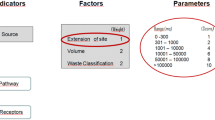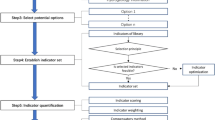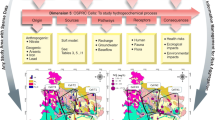
Overview
- Risk-based contaminated land management, is of great interest in the EU where this is a developing area. An EU directive on soil protection and risk based management of contaminated sites will be enforced in the next year or two
- There is no other book available that collects methodologies and tools in this field
- DSSs developed in Italy and Germany will be new to US users and will expand their potential resources
Access this book
Tax calculation will be finalised at checkout
Other ways to access
About this book
Decision Support Systems for Risk-Based Management of Contaminated Sites addresses decision making in environmental risk management for contaminated sites, focusing on the potential role of decision support systems in informing the management of chemical pollutants and their effects. Considering the environmental relevance and the financial impacts of contaminated sites all over the post-industrialized countries and the complexity of decision making in environmental risk management, decision support systems can be used by decision makers in order to have a more structured analysis of a problem at hand and define possible options of intervention to solve the problem.
Accordingly, the book provides an analysis of the main steps and tools for the development of decision support systems, namely: environmental risk assessment, decision analysis, spatial analysis and geographic information system, indicators and endpoints. Sections are dedicated to the review of decision support systems for contaminated land management and for inland and coastal waters management. Both include discussions of management problem formulation and of the application of specific decision support systems.
This book is a valuable support for environmental risk managers and for decision makers involved in a sustainable management of contaminated sites, including contaminated lands, river basins and coastal lagoons. Furthermore, it is a basic tool for the environmental scientists who gather data and perform assessments to support decisions, developers of decision support systems, students of environmental science and members of the public who wish to understand the assessment science that supports remedial decisions.
Similar content being viewed by others
Keywords
Table of contents (20 chapters)
-
Front Matter
Reviews
From the reviews:
"This three-part work is a compilation of articles summarizing the state of the art of decision support systems (DSS) as they are used in the management of contaminated sites. … Each chapter describes a specific tool, first outlining its structural elements, then providing an example case study. … The overall breadth of the tools … provides an excellent foundation in this emerging field. … This volume will be of interest to community planners, agency personnel, and environmental/legal professionals. Summing Up: Recommended. Graduate through professional collections." (B. Bero, Choice, Vol. 47 (2), October, 2009)
Editors and Affiliations
About the editors
Andrea Critto
Lecturer in Environmental Risk Assessment and research associate at Department of Environmental Sciences; senior researcher at Interdepartmental Centre for the Dynamic Interactions between Economy, Environment and Society (IDEAS), the University Ca’ Foscari of Venice, Italy.
His main research activity concerns Environmental Risk Assessment and Management associated with: a) development of Decision Support Systems for the integration of environmental, technological, economical and societal issues; b) formulation of Environmental Quality Standards and planning of environmental monitoring; c) selection/comparison of remedial technologies for contaminated sites.
Dr. Critto received his Ph.D. in Environmental Sciences at the University Ca’ Foscari of Venice, Italy, with specialization in Environmental Risk Assessment and GIS-based Decision Support Systems (DSS) for risk based environmental management.
Antonio Marcomini
Professor of Environmental Chemistry at the University Ca’ Foscari of Venice, he has been post-doctoral fellow at the University of Toronto (Canada) and research associate at the EAWAG-ETH Institute of Water Science and Technology , Duebendorf (Switzerland). He has written extensively on the environmental behaviour (i.e. identification and determination, degradation and bioaccumulation, fate and transport, etc.) of both naturally occurring and synthetic chemicals, on impact and human health/ecological risk assessment of chemical pollutants, on environmental sustainability of degraded land/ecosystems rehabilitation, and on tools (procedures, protocols, decision support systems) for environmental decision making. He is author/coauthor of approx. 160 publications appeared in peer reviewed international journals, as well as of book chapters. Coordinator/scientific responsible of several international and national projects, his current research work focuses on characterization and riskassessment of emerging pollutants, especially nanoparticles and nanomaterials.
Glenn W. Suter II
Glenn W. Suter II is Science Advisor in the U.S. Environmental Protection Agency’s National Center for Environmental Assessment-Cincinnati, and was formerly a Senior Research Staff Member in the Environmental Sciences Division, Oak Ridge National Laboratory, U.S.A. He has a Ph.D. in Ecology from the University of California, Davis, and 30 years of professional experience including 25 years of experience in ecological risk assessment. He is the principal author of three texts in the field of ecological risk assessment, editor of two other books and author of more than a hundred open literature publications. He is Associate Editor for Ecological Risk of Human and Ecological Risk Assessment, and Reviews Editor for the Society for Environmental Toxicology and Chemistry (SETAC). He has served on the International Institute of Applied Systems Analysis Task Force on Risk and Policy Analysis, the Board of Directors of SETAC, an Expert Panel for the Council on Environmental Quality, and the editorial boards of five journals. He is the recipient of numerous awards and honors; most notably, he is an Elected Fellow of the American Association for the Advancement of Science; and he received SETAC’s Global Founder’s Award, their award for career achievement, and the EPA’s Level 1 Scientific and Technical Achievement Award. His research experience includes development and application of methods for ecological risk assessment and ecological epidemiology, development of soil microcosm and fish toxicity tests, and environmental monitoring. His work is currently focused on the development of methods for determining the causes of biological impairments.
Bibliographic Information
Book Title: Decision Support Systems for Risk-Based Management of Contaminated Sites
Editors: Antonio Marcomini, Glenn Walter Suter II, Andrea Critto
DOI: https://doi.org/10.1007/978-0-387-09722-0
Publisher: Springer New York, NY
eBook Packages: Earth and Environmental Science, Earth and Environmental Science (R0)
Copyright Information: Springer-Verlag US 2009
Hardcover ISBN: 978-0-387-09721-3Published: 15 December 2008
Softcover ISBN: 978-1-4419-3524-3Published: 31 August 2011
eBook ISBN: 978-0-387-09722-0Published: 16 December 2008
Edition Number: 1
Number of Pages: XX, 436
Number of Illustrations: 90 b/w illustrations
Topics: Pollution, general, Environmental Management, Geographical Information Systems/Cartography, Ecotoxicology, Environmental Economics



